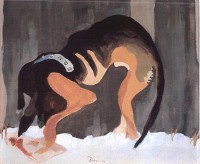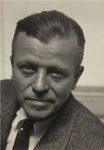
Arthur G. Dove
American , 1880-1946
Hound (Hound That Came with the House), 1934
oil on canvas
SBMA, Gift of Mr. and Mrs. Richard Foster
1995.13

Arthur Dove - undated photo
"What constitutes American painting? When a man paints the El, a 7740 house, or a miner's shack, he is likely to be called by his critics, American. These things may be in America, but it's what is in the artist that counts." - Arthur Dove
RESEARCH PAPER
Hound (Hound that Came with the House) reveals a novel technique in style. No lines are "filled in", simply wide shapes as expressed with a palette knife or wide brush: no less are the muscles in the dog’s leg shown because they are not drawn, they are there because of the animal’s musculature which causes them to be apparent. There is the lost head probably chewing, the left front leg holding the paper of food, the tail curled for warmth as well as comfort; the collar suggested with brass nails, the background old farm fence done in broad strokes, the animals feet lost in the snow. Important circular effects express the rigid strength of the dog, as well as the painter’s emotion regarding the animal’s intensity. We are in front of the picture, aware of the collar, almost a reminder of America’s earlier painters by some forty years who, in the Western United States, were developing tonalism (i.e., shades and tints of the same hue.)
Dove was born in the East and he was brought up in upper New York State. He spent much of his childhood in the woods near his home. Blessed by having a neighbor take interest in this only child, he and his friend, Weatherly, hiked in the hills, fished and drew pictures together. His friend taught him to really see the spines of leaves, the gradation of color, and the shapes in Nature.
Though he married early, soon after graduating from Cornell University in 1903, the work he did thereafter for three years did not make him happy. He did illustrations for commercial magazines and newspapers, and finally decided to travel in Europe for "the European experience", as most artists of his time felt was necessary. He stayed in Paris for a year and a half, not liking the European approach, which was, to his way of thinking, "historical" art. For Arthur Dove, being a modern artist meant staying abreast of significant developments and changes. While the French turned to the past, Dove turned to nature as a way to achieve universal meaning.
His philosophy on light, for instance… "I’ve always had the feeling that the condition of light was directly related to the line motif in form and color…a condition of existence is important. Every object in nature has it…leaves, trees, animals all have, a condition of light. They cut the color cone with their own individual curve."
For Dove, line makes form, and mass makes form. He was an intellectual artist who had the invincible need to believe in a transcendental reality…invisible and interior. It was his purpose to give expression to that reality…invisible and interior. It was his purpose to give expression to that reality which eludes scientific measurement.
By 1941, Arthur Dove was virtually an invalid, having had two strokes and kidney disease. Despite failing health, his last few years were artistically vital and productive.
Prepared by Virginia Wardwell for the Docent Council December, 1996
Bibliography
Cohn, Sherrye. Arthur Dove, Nature as Symbol. U.M.I. Research Press, Ann Arbor,
Michigan, 1985.
Haskell, Barbara. Arthur Dove. San Francisco Museum of Art, 1974.
Turner, Elizabeth Hutton. In the American Grain…The Stieglitz Circle at the Phillips
Collection. Counterpoint, Washington, D.C. in association with the Phillips
Collection. Copyright 1995.
The American Art Journal, "Arthur Dove…Life and Work" with a Catalogue Raisonne.
University of Delaware Press Books.
Santa Barbara Museum of Art Bulletin, July/August, 1995
SBMA CURATORIAL LABELS
After a trip to Paris and the South of France, where he fell under the spell of Matisse and Picasso, Dove returned to the States, developing one of the most radically abstract modes of painting of all American artists in his generation. Overtly non-representational, his use of arbitrary colors and simplified forms expressed his belief in the interpenetration of objects and environments. This whimsical painting was done after his return to Seneca County, New York to settle his family’s estate in 1933. The interlocking, flattened forms which barely suggest the canine specified by the title are typical of his lyrical sense of the essential shapes that form the totality of nature. Dove’s success as a leader of progressive art is attested by the fact that the collector and art historian Duncan Phillips had him on a retainer so as to have first dibs on any newly exhibited works.
- Highlights of American Art, 2020
